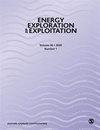Impact of coal evolution on formation of tight sandstone reservoirs: A case study in the Daniudi gas field, Ordos Basin, China
IF 1.6
4区 工程技术
Q4 ENERGY & FUELS
引用次数: 0
Abstract
Tight sandstone gas in coal-bearing strata has become an important unconventional gas worldwide. This research aims at understanding the impacts of coal evolution on diagenesis and reservoir quality of sandstones by means of thin section, cathode luminescence (CL), scanning electron microscope (SEM), stable isotope analysis, and fluid inclusions. The results show that carbonate cement was the main type of cement developed in tight sandstone reservoirs, of which the carbonate ions were jointly provided by coal layers and reaction in adjacent mudstones. For sandstones close to coal layers, their carbonate ions were mainly controlled by coal evolution and there was various carbonate cement developed due to cations supplied by seawater and the intense dissolution of volcanic fragments and feldspars. Combined with coal thermal simulation and burial history, it implies that at different maturity stages of coal evolution, its impact on sandstone diagenesis was different. In the early stage, the main product was CO2, which caused the dissolution of early calcite and promoted intense compaction. In the mature stage, CO2 and other hydrocarbon gases were released, resulting in more dissolution and silica cementation. In the over-mature stage, the main product was methane, and CO2 that did not spill out preserved by forming carbonate cement. The coal evolution had a strong impact on the reservoir quality of sandstone with large grain sizes, but little effect on medium- and fine-grained sandstones. High porosity and low permeability reservoirs were usually formed in small conglomerates and coarse-grained sandstones away from coal layers. While low porosity and high permeability reservoirs were distributed close to coal layers. This study aids in understanding the formation mechanism of tight sandstone reservoirs in coal measures and provides theoretic support for further exploration.煤演化对致密砂岩储层形成的影响——以鄂尔多斯盆地大牛地气田为例
含煤地层致密砂岩气已成为世界范围内重要的非常规天然气。通过薄片、阴极发光(CL)、扫描电镜(SEM)、稳定同位素分析和流体包裹体等手段,了解煤演化对砂岩成岩作用和储层质量的影响。结果表明:碳酸盐岩胶结物是致密砂岩储层发育的主要胶结物类型,碳酸盐岩离子由煤层和邻近泥岩共同提供;对于靠近煤层的砂岩,碳酸盐离子主要受煤的演化控制,由于海水提供的阳离子以及火山碎屑和长石的强烈溶蚀作用,形成了多种碳酸盐胶结物。结合煤热模拟和埋藏历史,表明在煤演化的不同成熟阶段,其对砂岩成岩作用的影响是不同的。早期主要产物为CO2,使早期方解石溶蚀,促进强压实作用。在成熟阶段,CO2和其他烃类气体被释放,导致更多的溶解和硅胶结。过成熟阶段主要产物为甲烷,未外溢的CO2通过形成碳酸盐胶结物保存下来。煤的演化对大粒度砂岩储层质量影响较大,对中、细粒度砂岩储层质量影响较小。高孔低渗储层通常形成于远离煤层的小砾岩和粗粒砂岩中。而低孔高渗储层则分布在煤层附近。该研究有助于认识煤系致密砂岩储层的形成机理,为进一步勘探提供理论支持。
本文章由计算机程序翻译,如有差异,请以英文原文为准。
求助全文
约1分钟内获得全文
求助全文
来源期刊

Energy Exploration & Exploitation
工程技术-能源与燃料
CiteScore
5.40
自引率
3.70%
发文量
78
审稿时长
3.9 months
期刊介绍:
Energy Exploration & Exploitation is a peer-reviewed, open access journal that provides up-to-date, informative reviews and original articles on important issues in the exploration, exploitation, use and economics of the world’s energy resources.
 求助内容:
求助内容: 应助结果提醒方式:
应助结果提醒方式:


